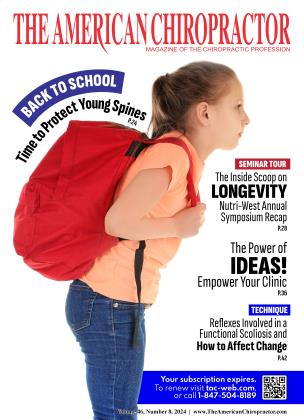Scoliosis, Backpacks, and Back to School
POSTURE
Christine Foss
MD, DC, MS.ED., ATC, DACBSP, DACRB, ICSC
AS WE START THINKING about the upcoming school year, new clothes, notebooks, and backpacks come to mind. How do we send our kids to school while considering injury prevention? One very important topic is the load, position, and effect a backpack has on our children. Research by Betty et al. found that a load of 17% of body weight or more significantly changes spinal alignment.1 The change in spinal alignment is not only a precursor for idiopathic scoliosis but for the start of compensatory patterns of muscle use and disuse termed “kinetic chain faults.”
Kinetic chain faults are best described as the “why” behind most injuries. The fallen medial arch is the perfect example. When a child hyperpronates, it sets off a series of events that rapidly change the biomechanisms of the body. The cascade of hyperpronation is navicular drop, talar eversion, calcaneus eversion, tibial internal rotation, femoral internal rotation, increased sacral incidence, lumbar extension, and forward head carriage. As one would guess, a very long list of injuries can occur from this single faulty position. The addition of a weighted backpack exaggerates hyperpronation and exponentially increases injury predisposition.
How Can We Help?
One effective way to maintain spinal alignment and reduce injury predisposition in school-aged children is to have them regularly visit the chiropractor. This visit should also include a posture and gait screening in which the feet are scanned for signs of hyperpronation, supination, or faulty gait patterns.
Figure 1 demonstrates a left valgus heel. This classic sign of a hyperpronated foot creates a kinetic chain of injury predisposition. Figure 2 shows the position of the left medial knee resulting from the foot position. This speaks to the research on increased ACL tears in individuals with hyperpronated feet.2 By aligning the body with chiropractic care and additionally supporting the feet with custom flexible orthotics, we can prevent a plethora of injuries.
What Age Is Appropriate to Place Orthotics in Shoes?
The question of when we can place an orthotic in a child’s shoe is frequently raised. The answer to that is in the formation of the plantar vault and the foot’s three arches. A four-year study on arch development in children revealed that the arches of the feet develop regardless of the footwear. However, the development of the arches is faster in children with an arch support placed during the first two years.3
“...the development of the arches is faster in children with an arch support placed during the first two years”
Additional research demonstrates that the medial longitudinal arch (MLA) develops most rapidly until age six.4 After that age, research is conflicting about the status of MLA development. Therefore, we can sum up the research findings by saying that supporting the arch at any age does not have negative ramifications. However, this research does tell us that the type of footwear is essential, allowing room and flexibility for foot intrinsic strength and arch development.4
Backpack Fitting
Another tool to prevent injury this school year is to check the proper fit of children’s backpacks. This simple assessment is easy to implement in the office during an adjustment. Checking backpack fit is a game-changer for keeping the spine aligned. Asking parents to bring backpacks into the office for a fitting is a great way to start the year off right.
Some important steps when fitting a backpack:
‘ The bigger the backpack, the more stuff will pile inside, making it heavier. So it’s a good idea to select a smaller backpack to keep the weight to a minimum.”
1. Wear the backpack on both shoulders.
2. The shoulder straps should fit comfortably over and under the arms, allowing them to move freely.
3. The backpack’s shoulder straps should be fitted appropriately, allowing it to sit at the waist or slightly above it.
4. The backpack should not be wider than the child’s body.
5. The backpack should not exceed 10 to 15% of the child’s weight.
The bigger the backpack, the more stuff will pile inside, making it heavier. So it’s a good idea to select a smaller backpack to keep the weight to a minimum.
In conclusion, getting a jump start on the year with injury and scoliosis prevention opens the door for success. Chiropractors can play a role in the care and protection of spinal alignment and the preservation of the kinetic chain by checking spinal alignment, backpack safety, and scanning the feet for imbalances. This formula helps each child in the journey that begins on the first day of school.
Dr. Christine Foss is the director of the certified chiropractic sports physician program for Northeast Chiropractic College. She was named the 2020 American Chiropractic Association Sports Council Chiropractor of the Year and was the 2023 International Federation of Sports Chiropractic Educator of the Year. Dr. Foss is currently serving as the director of education at Foot Levelers.
References:
1. Bettany-Saltikov J, Warren J, Stamp M. Carrying a rucksack on either shoulder or the back, does it matter? Load-induced functional scoliosis in “normal” young subjects. Stud Health Technol Inform. 2008;140:221-4. PMID: 18810027.
2. Beckett ME, Massie DL. Bowers KO, Stoll DA. Incidence of hyperpronation in the ACL injured knee: a clinical perspective. J Athl Train. 1992;27(l):58-62. PMID: 16558134; PMCID: PMC1317132
3. Gould N, Moreland M, Alvarez R, Trevino S, Fenwick J. Development of the child’s arch. Foot Ankle. 1989 Apr;9(5):241-5. doi: 10.1177/107110078900900506. PMID: 2731836.
4. Tong JW, Kong PW. Medial longitudinal arch development of children aged 7 to 9 years: longitudinal investigation. Phys Then 2016 Aug;96(8): 1216-24. doi: 10.2522/ptj.20150192. Epub 2016 Feb 18. PMID: 26893508.
 View Full Issue
View Full Issue






